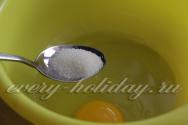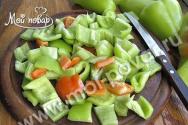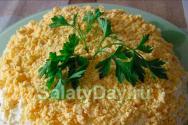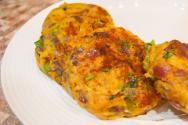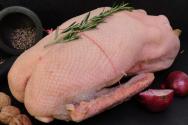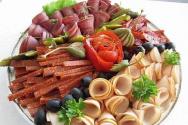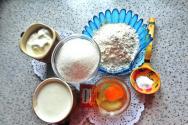Wheat is soft and hard. Soft wheat: description, cultivation, application. Types of soft wheat grains
The main differences in the chemical composition of soft and durum wheat are:
– the composition of soft wheat grains contains a lot of biologically accessible starch, unlike durum wheat, the starch of which has low bioavailability, since it is in a bound state with proteins, and its grains are not destroyed during heat treatment. This determines the significantly higher calorie content of soft wheat compared to durum wheat. The starch grains of soft wheat are larger, the flour from such wheat is white, crumbly, absorbs little water, so bread made from it quickly becomes stale. The starch grains of durum wheat are smaller and harder, and the flour made from it is able to absorb water in large quantities. Durum wheat carbohydrates are more complex in structure compared to soft varieties, and the body needs to spend significantly more energy to break them down;
– durum wheat contains more carotenoids (especially beta-carotene), so flour made from it often has a creamy tint and less fat;
– durum wheat contains more protein and more gluten ( gluten free) – an alcohol-soluble protein complex from the group of alpha-gliadins, which is associated with baking qualities. It is the content of gluten that is associated with the problem of some people who are hypersensitive to it, which arises when consuming products made from durum wheat flour. In such patients, who are highly sensitive to alpha-gliadins, consumption of baked goods leads to the development of a disease known as celiac disease(gluten enteropathy). There are several theories of the pathogenesis of celiac disease, the main ones being toxic and immunological. The essence of the toxic theory is that it is possible (although not yet precisely proven) that one of the peptidases is missing in the mucosa of patients, while gluten and its glutamine-rich fragments are poorly broken down into dipeptides and amino acids, and ultimately accumulate in the mucosa, having a toxic effect on it. In accordance with the immunological theory, alpha-gliadins have common immunodeterminant groups with proteins of enterocytes (epithelial cells of the small intestine). When gluten enters the blood, patients develop an autoimmune reaction that affects enterocytes. With a weak lesion, a violation of intestinal absorption is observed, and with a strong lesion, intestinal perforation is observed;
– durum wheat contains significantly more essential amino acids, especially tryptophan and phenylalanine;
– durum wheat contains significantly less phytosterols, in particular, beta-sitosterol: its content in durum wheat is 14 times less than in soft wheat (it can be used to determine the addition of soft wheat to durum wheat in the production of pasta);
– unlike soft wheat, durum wheat contains quite a lot of purine bases, which is necessary should be taken into account in patients with gout.
Wheat is a popular cereal crop common in many countries around the world. To date, thousands of plant varieties are known. At the same time, the main classification allows us to divide wheat into the following varieties: hard and soft. Despite the fact that both types are similar, a significant number of distinctive features can be identified.
Places where soft and durum wheat grow
When people talk about wheat in Russia, in most cases we are talking about soft varieties, which account for up to 95% of the total wheat. Soft varieties can only grow in regions where the climate is humid. For this reason, soft wheat grows in Russia, Western Europe, Australia, and the CIS.

Durum varieties initially require a dry and continental climate. In this regard, the regions of wheat growth are as follows: Argentina, Canada, USA, Asia, North Africa.
What is the difference between soft and durum wheat varieties?
First of all, the difference lies in the appearance of the ears and grains.
- Soft wheat always has thin and hollow straws.
- Hard varieties can please you with a thick-walled stem.
- Soft wheat grains always have a mealy, glassy or semi-vitreous consistency. The color can vary from white to dark red.
- Durum wheat varieties are characterized by hard grains of small size. The color may be yellowish or brown.
- The starch particles in soft wheat will be large and soft. As a result, the flour may be crumbly and thin, but it practically does not absorb liquid. In addition, flour is prone to rapid hardening, which is why it is used for making bread and confectionery products.
- Durum wheat starch particles may be hard and small. They allow you to prepare fine-grained flour, which contains an increased amount of gluten. Among the features, it should be noted the ability to absorb water and the absence of callousness for a long time. Durum wheat flour is an ideal option for pasta products.

Hard and soft wheat: which is healthier?
Beneficial properties are guaranteed in every case. So, what is the composition of wheat?
- Protein.
- Fats.
- Complex carbohydrates.
- Essential oils.
- Fructose.
- Vitamins A, C, E, F, PP.
- Calcium.
- Bromine.
- Iron.
- Phosphorus.
Despite this, products traditionally made from durum wheat flour often become healthier. This is due to the increased amount of plant proteins, mineral components, and fiber. In addition, pasta made with durum flour can successfully retain its shape even when cooked. It should be noted that pasta prepared using hard flour is usually designated group A, soft pasta - B. On imported packaging, the indicator of hard word flour will be the word durum or semolina.
Properties of wheat: benefits and harms
Wheat is one of the healthiest types of plant foods, but not all dishes made from this ingredient can be healthy.
If a dish is prepared from soft wheat varieties, there is the possibility of obtaining carbohydrates with a high glycemic index. As a result, the consumption of products leads to sudden changes in blood sugar levels and the appearance of fat deposits. 
Products made from durum wheat can be useful, since they do not have significant glycemic index. In addition, wheat contains protein, fiber, complex carbohydrates, minerals and vitamins, which guarantees maximum benefits. At the same time, the main advantage is that there is no risk of the human body gaining fat mass. Carbohydrates that enter the body can be absorbed slowly and over a long period of time, thanks to which the body can be supplied with energy for a long time.
What beneficial properties do wheat-based products have?
Products for the preparation of which it is customary to use durum wheat and some types of soft wheat products have the following beneficial properties:
- It is assumed that glycogen stores will be successfully replenished, resulting in an immediate improvement in human health. Moreover, people who lead an active lifestyle are primarily interested in such a result.
- It is supposed to increase the production of serotonin, which is necessary for improving mood. A worthy fight against stress, insomnia, depression, and headaches is guaranteed.
- A set of vitamins and mineral components allows you to successfully strengthen bone and muscle mass. Moreover, the level of hemoglobin in the blood increases.
- There is an opportunity to eliminate the adverse effects of radicals.
- Optimal prevention of body aging and the development of cancer is guaranteed.
- Dietary fiber allows you to cleanse the intestines of toxins and waste, thereby improving your health in the shortest possible time.
Knowing the main features of hard and soft wheat varieties, beneficial properties and potential harm, you can correctly use one of the most popular cereal crops in food.
| IPNI | |
| TPL |
Soft wheat, or Summer wheat(lat. Triticum aestivum) - a type of annual herbaceous plants of the genus Wheat ( Triticum) family Cereals ( Gramineae), or Poagrass ( Poaceae).
Botanical description
The plant reaches a height of 40-100 cm, rarely up to 150 cm. The straw is thin, hollow inside. The nodes are bare or pubescent only in the early stages of plant life. The leaf blade is 6-16 mm wide, at first soft and pubescent, but then becomes bare and hard.
Usage
Soft wheat is used as a cereal for the preparation of bakery products, as well as for the production of malt (wheat beer). A by-product of threshing is wheat bran, which is used in livestock farming as livestock feed or eaten.
Small amounts of soft and durum wheat are used for industrial starch production. Other grains are more important in this regard, for example, 80% of starch is obtained from corn, and wheat starch makes up only 9%. . Wheat containing 70% starch is more suitable for industrial applications than wheat containing 60% starch. In addition, wheat is used to produce bioethanol.
Seed composition
 The composition of seeds naturally varies depending on environmental conditions (soil, climate) and cultivation technology (fertilizers, pest control products).
The composition of seeds naturally varies depending on environmental conditions (soil, climate) and cultivation technology (fertilizers, pest control products).
Below is the composition per 100 g of the edible part of the seeds:
|
|
|
|
"" - in some countries significantly higher values
1 - semi-necessary
1 mg = 1000 µg
Synonymy
Write a review about the article "Soft wheat"
Notes
Literature
- Nevsky S. A.// Flora of the USSR: in 30 volumes / ch. ed. V. L. Komarov. - M.-L. : Publishing House of the USSR Academy of Sciences, 1934. - T. II / ed. volumes R. Yu. Rozhevits, B. K. Shishkin. - pp. 687-688. - 778 + XXXIII p. - 5175 copies.
- Deutsche Forschungsanstalt für Lebensmittelchemie (DFA), Garching (Hrsg.): Lebensmitteltabelle für die Praxis. Der kleine Souci · Fachmann · Kraut. 4 Auflage. Wissenschaftliche Verlagsgesellschaft mbH, Stuttgart 2009, ISBN 978-3-8047-2541-6, S. 239
Links
- Soft wheat- article from the Great Soviet Encyclopedia.
- : information about the taxon in the Plantarium project (identifier of plants and illustrated atlas of species). (Retrieved July 23, 2012)
Excerpt characterizing soft wheat
“Come on, Natasha,” Sonya told her. “I see you’re right, but take out the top one.”“I don’t want to,” Natasha shouted, holding her loose hair over her sweaty face with one hand and pressing the carpets with the other. - Yes, press, Petka, press! Vasilich, press! - she shouted. The carpets pressed and the lid closed. Natasha, clapping her hands, squealed with joy, and tears flowed from her eyes. But it only lasted for a second. She immediately set to work on another matter, and they completely believed her, and the count was not angry when they told him that Natalya Ilyinishna had canceled his order, and the servants came to Natasha to ask: should the cart be tied up or not and is it sufficiently imposed? The matter progressed thanks to Natasha’s orders: unnecessary things were left behind and the most expensive ones were packed in the closest possible way.
But no matter how hard all the people worked, by late night not everything could be packed. The Countess fell asleep, and the Count, postponing his departure until the morning, went to bed.
Sonya and Natasha slept without undressing in the sofa room. That night, another wounded man was transported through Povarskaya, and Mavra Kuzminishna, who was standing at the gate, turned him towards the Rostovs. This wounded man, according to Mavra Kuzminishna, was a very significant person. He was carried in a carriage, completely covered with an apron and with the top down. An old man, a venerable valet, sat on the box with the cab driver. A doctor and two soldiers were riding in the cart behind.
- Come to us, please. The gentlemen are leaving, the whole house is empty,” said the old woman, turning to the old servant.
“Well,” answered the valet, sighing, “and we can’t get you there with tea!” We have our own house in Moscow, but it’s far away, and no one lives.
“You are welcome to us, our gentlemen have a lot of everything, please,” said Mavra Kuzminishna. - Are you very unwell? – she added.
The valet waved his hand.
- Don’t bring tea! You need to ask the doctor. - And the valet got off the box and approached the cart.
“Okay,” said the doctor.
The valet went up to the carriage again, looked into it, shook his head, ordered the coachman to turn into the yard and stopped next to Mavra Kuzminishna.
- Lord Jesus Christ! - she said.
Mavra Kuzminishna offered to carry the wounded man into the house.
“The gentlemen won’t say anything...” she said. But it was necessary to avoid climbing the stairs, and therefore the wounded man was carried into the outbuilding and laid in the former room of m me Schoss. The wounded man was Prince Andrei Bolkonsky.
The last day of Moscow has arrived. It was clear, cheerful autumn weather. It was Sunday. As on ordinary Sundays, mass was announced in all churches. No one, it seemed, could yet understand what awaited Moscow.
Only two indicators of the state of society expressed the situation in which Moscow was: the mob, that is, the class of poor people, and the prices of objects. Factory workers, courtyard workers and peasants in a huge crowd, which included officials, seminarians, and nobles, went out to the Three Mountains early in the morning. Having stood there and not waiting for Rostopchin and making sure that Moscow would be surrendered, this crowd scattered throughout Moscow, into drinking houses and taverns. Prices that day also indicated the state of affairs. The prices for weapons, for gold, for carts and horses kept rising, and the prices for pieces of paper and for city things kept going down, so that in the middle of the day there were cases when the cabbies took out expensive goods, like cloth, for nothing, and for a peasant's horse paid five hundred rubles; furniture, mirrors, bronzes were given away for free.
In the sedate and old Rostov house, the disintegration of previous living conditions was expressed very weakly. The only thing about people was that three people from a huge courtyard disappeared that night; but nothing was stolen; and in relation to the prices of things, it turned out that the thirty carts that came from the villages were enormous wealth, which many envied and for which the Rostovs were offered huge amounts of money. Not only were they offering huge sums of money for these carts, but from the evening and early morning of September 1st, orderlies and servants sent from the wounded officers came to the Rostovs’ yard, and the wounded themselves, who were placed with the Rostovs and in neighboring houses, were dragged along, and begged the Rostovs’ people to take care of that they be given carts to leave Moscow. The butler, to whom such requests were addressed, although he felt sorry for the wounded, resolutely refused, saying that he would not even dare to report this to the count. No matter how pitiful the remaining wounded were, it was obvious that if they gave up one cart, there was no reason not to give up the other, and give up everything and their crews. Thirty carts could not save all the wounded, and in the general disaster it was impossible not to think about yourself and your family. This is what the butler thought for his master.
Waking up on the morning of the 1st, Count Ilya Andreich quietly left the bedroom so as not to wake up the countess who had just fallen asleep in the morning, and in his purple silk robe he went out onto the porch. The carts, tied up, stood in the yard. Carriages stood at the porch. The butler stood at the entrance, talking with the old orderly and the young, pale officer with his arm tied. The butler, seeing the count, made a significant and stern sign to the officer and orderly to leave.
- Well, is everything ready, Vasilich? - said the count, rubbing his bald head and looking good-naturedly at the officer and orderly and nodding his head to them. (The Count loved new faces.)
- At least harness it now, your Excellency.
- Well, that’s great, the countess will wake up, and God bless you! What are you doing, gentlemen? – he turned to the officer. - In my house? – The officer moved closer. His pale face suddenly flushed with bright color.
- Count, do me a favor, let me... for God's sake... take refuge somewhere on your carts. Here I have nothing with me... I’m in the cart... it doesn’t matter... - Before the officer had time to finish, the orderly turned to the count with the same request for his master.
- A! “Yes, yes, yes,” the count spoke hastily. - I'm very, very happy. Vasilich, you give orders, well, to clear one or two carts, well... well... what is needed... - the count said in some vague expressions, ordering something. But at the same moment, the officer’s ardent expression of gratitude already cemented what he had ordered. The count looked around him: in the courtyard, at the gate, in the window of the outbuilding, the wounded and orderlies could be seen. They all looked at the count and moved towards the porch.
- Please, your Excellency, to the gallery: what do you order about the paintings? - said the butler. And the count entered the house with him, repeating his order not to refuse the wounded who asked to go.
“Well, well, we can put something together,” he added in a quiet, mysterious voice, as if afraid that someone would hear him.
At nine o'clock the countess woke up, and Matryona Timofeevna, her former maid, who served as chief of gendarmes in relation to the countess, came to report to her former young lady that Marya Karlovna was very offended and that the young ladies' summer dresses could not stay here. When the countess questioned why m me Schoss was offended, it was revealed that her chest had been removed from the cart and all the carts were being untied - they were removing the goods and taking with them the wounded, whom the count, in his simplicity, ordered to be taken with him. The Countess ordered to ask for her husband.
Wheat m "yaka
Triticum aestivum L., Tritiom vulgare Vill Poaceae family - Gramineae
Historical reference. Wheat- one of the oldest cultivated plants - was known to the ancient peoples of Europe, Asia, and North Africa already in the Neolithic era. 4 thousand years BC. e. it was cultivated in China, Egypt, Mesopotamia, and on the territory of modern Switzerland. This culture has a long and rich history among many peoples, including the Slavs. The word “wheat” is common Slavic. It is based on another well-known word - “millet”. The name is given on a “production” basis: “millet” is a derivative of “pyhati” - pound, shove. Thus, the original meaning of two ancient words: “millet” - crushed, “wheat” - a grain that is pounded. It is interesting that the ancient Latin “triticum”, which became a scientific botanical name, is close in meaning: “tritus” - rubbed, worn out.
The nutritional and healing properties of cereals and wheat were highly valued in Ancient Rus'. Decoctions of crushed grain, crumbs and bread crusts were used in the treatment of many ailments. “It strengthens all the insides and strengthens bodily strength” - this is what was said about wheat in the Russian folk herbal book of the 17th century. "Cool helicopter city."
Description.- an annual herbaceous plant with erect stems. The leaves are flat, broadly linear. The inflorescence is a complex spike. The spikelets are located on the projections of the spike shaft, five-flowered. The plant can reach a height of 1.5 m. It blooms in June - August.
Spreading. The plant is widely cultivated in fields, mainly in the steppe and forest-steppe zones.
Scientists have long been interested chemical composition this most important cereal. As a result of scientific research, it was found that wheat contains starch and other carbohydrates (more than 60%), various proteins - leukosin, glutenin, gliadin (up to 22%), as well as fat, fiber, ash substances - phosphorus, potassium, calcium, magnesium and others (up to 2%), various enzymes. The nutritional and medicinal value of this plant comes from vitamins B1, E, choline and a number of other substances found in significant quantities.
Application. A part of the plant is used - the grain. Grain, flour, cereals, and bran are obtained from it. There is hardly any need to talk about the importance of wheat as a food product. However, not everyone probably knows that this ancient agricultural crop has long been used in Russian folk medicine. Most often it is a decoction of wheat grains, which has general strengthening and emollient properties. The decoction is prescribed to restore strength after severe, long-term illnesses. A decoction of bran with the addition of honey - for respiratory diseases, cough. A decoction of wheat bread crumb - for simple and bloody diarrhea. To speed up the maturation of abscesses or to resolve tumors, apply a crumb of wheat bread dipped in hot milk. A decoction and poultice made from bran is a proven cosmetic product for softening the skin, this is not a complete list... Preparations from soft wheat have found application in scientific medicine. In particular, a thick extract from wheat germ “Cholef” (fecholine), prescribed for the treatment of patients with various forms of muscular dystrophy. Another preparation was obtained from wheat grains - a thick, resinous liquid of dark brown color with the smell of burnt grain, known as “Mitroshin liquid”. This is a very effective remedy for skin diseases - eczema, scaly lichen, neurodermatitis, inflammation of the hair follicles (sycosis).
As studies have shown, when wheat grains are sprouted, the amount of vitamins B6 and C increases by more than 5 times, vitamin B1 by more than 1.5, B2 by 13.5, and folic acid by 4 times. The concentration of natural antibiotics and growth stimulants in grain increases sharply. That is why scientists classify sprouted wheat grains as the most valuable health products, especially necessary for people working in the Far North, for people engaged in heavy physical labor.
Grain sprouts are easy to prepare at home. Cleanly washed grains are wrapped in a cloth previously moistened with warm water and left in a room at a temperature of 22-24 ° C. The top layer of fabric is periodically moistened until sprouts appear.
Sprouted grain is an excellent healing food. They eat it without seasoning. Fruits are a good addition. However, the grain itself can serve as a seasoning. It must be dried, ground in a coffee grinder and added to food in this form. Sprouts are recommended to be consumed within 1-2 weeks for breakfast and lunch, the daily dose is up to 50 g. The most acceptable time of year is the end of winter and the beginning of spring.
Among the wide variety of grain crops, durum wheat varieties occupy a leading position in the modern agro-industrial complex. This popularity is due not only to the excellent characteristics of this crop, but also to the ability to create optimal conditions for its cultivation.
If we consider the agricultural map of wheat cultivation in Russia, then the vast expanses of the Kuban steppe zone are undoubtedly considered the best for this crop. However, other regions may also become quite promising.
1 The most common varieties and types of wheat
When novice farmers wonder where wheat is grown and which varieties are the best, they should first understand the peculiarities of cultivating this cereal.
Traditionally, the best regions are the middle ones, bordering on subtropical latitudes, which are characterized by fairly mild winters. This plant prefers a fairly dry and hot climate, tolerates atmospheric and soil drought well, is undemanding in care and has good yield.
Wheat classification traditionally divides it into groups depending on the time of sowing, physical and nutritional characteristics of the grain.
So, depending on the time of sowing, it can be:
- spring– these crops are more thermophilic and are cultivated in addition to the Krasnodar Territory, also in the Rostov, Saratov, Orenburg and Volgograd regions, in the west of Siberia and in the Stavropol Territory;
- winter– this variety is intended for winter sowing, is characterized by sufficient resistance to light frosts and is preferably cultivated in the Transcaucasus and Central Asia.
Winter wheat is considered unique, since the process of its cultivation and selection of new varieties involves meeting fairly strict vernalization requirements. Vernalization itself is an effective technique for stimulating increased flowering and fruiting, the effectiveness of which is based on the use of a natural decrease in temperature. This sectioning method makes it possible to create varieties that are resistant to various external influences, the growing process of which enters the active phase only when the sprouts and future ovary are no longer threatened by temperature changes.
It is noteworthy that the harvest time of winter and spring wheat coincides and occurs at the end of August and beginning of September.

Depending on the characteristics of the grain, wheat is divided into three main groups (types):
- durum wheat varieties are distinguished by a high content of protein and protein compounds in the grain composition, which allows it to be used in the production of the best grades of bread flour;
- soft wheat consists mainly of carbohydrates (starch), due to which the flour obtained from it is used for baking baked goods with an easily crumbling structure (baguettes, cookies and sponge cakes);
- Durum is one of the varieties of durum wheat, the main component of which is gluten.
With similar taste qualities, it should be noted that there is a significant difference between soft wheat and hard wheat - the carbohydrate content and, accordingly, different nutritional value. It has been scientifically proven that food products made from durum wheat can safely be classified as healthy food and help normalize metabolism. At the same time, any soft wheat product is an easily digestible carbohydrate, which can cause weight gain and more serious consequences.
Durum and soft wheat varieties are widely used in the food industry. The main product categories of their wheat raw materials are semolina, semolina, wafer cups, the vast majority of varieties of baked goods, dumplings, meat deboning mixtures.
1.1 Review of winter wheat varieties (video)
Durum and/or soft wheat varieties are selected depending on the climatic conditions in the growing region, as well as production needs. If proper agricultural practices are followed, both soft and durum wheat are distinguished by good productivity indicators, resistance to the climatic conditions of the region and various diseases.
2.1 Variety Irishka
2.3 Varieties Orenburgsky and Novodonsky
If you plan to give preference to a crop such as durum wheat, we recommend the Orenburg and Novodonskaya varieties. Like Zlata, they belong to spring crops, which predominantly represent this branch of agriculture.
Both varieties are distinguished by high yields and good resistance to possible climatic and temperature changes. Among winter crops, Donskoy Yantar deserves special attention - a highly productive durum variety grown mainly in steppe regions. We should also not forget that new varieties of winter wheat appear constantly.

As practice shows, durum varieties are more promising. Despite the fact that in the pasta industry of the food industry this particular variety of wheat is predominant (its share in production is just over 90%), about 30% of the area planned for this crop as a whole is allocated for the cultivation of durum wheat.
The official reason that durum wheat slows down its growth on a national scale is low profitability due to the lack of land absolutely suitable for cultivation; for farms, the profitability of growing durum wheat is significantly higher.
